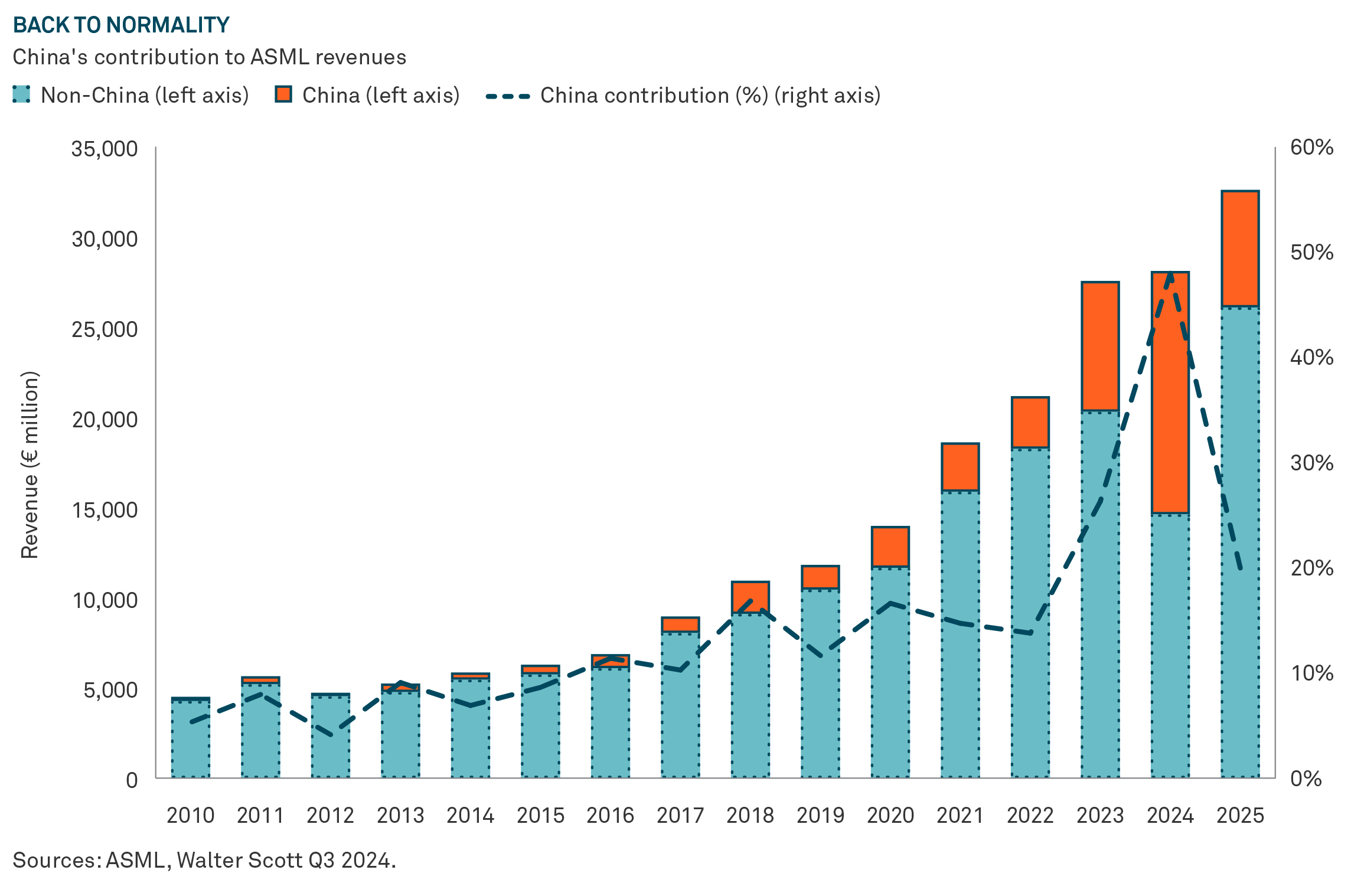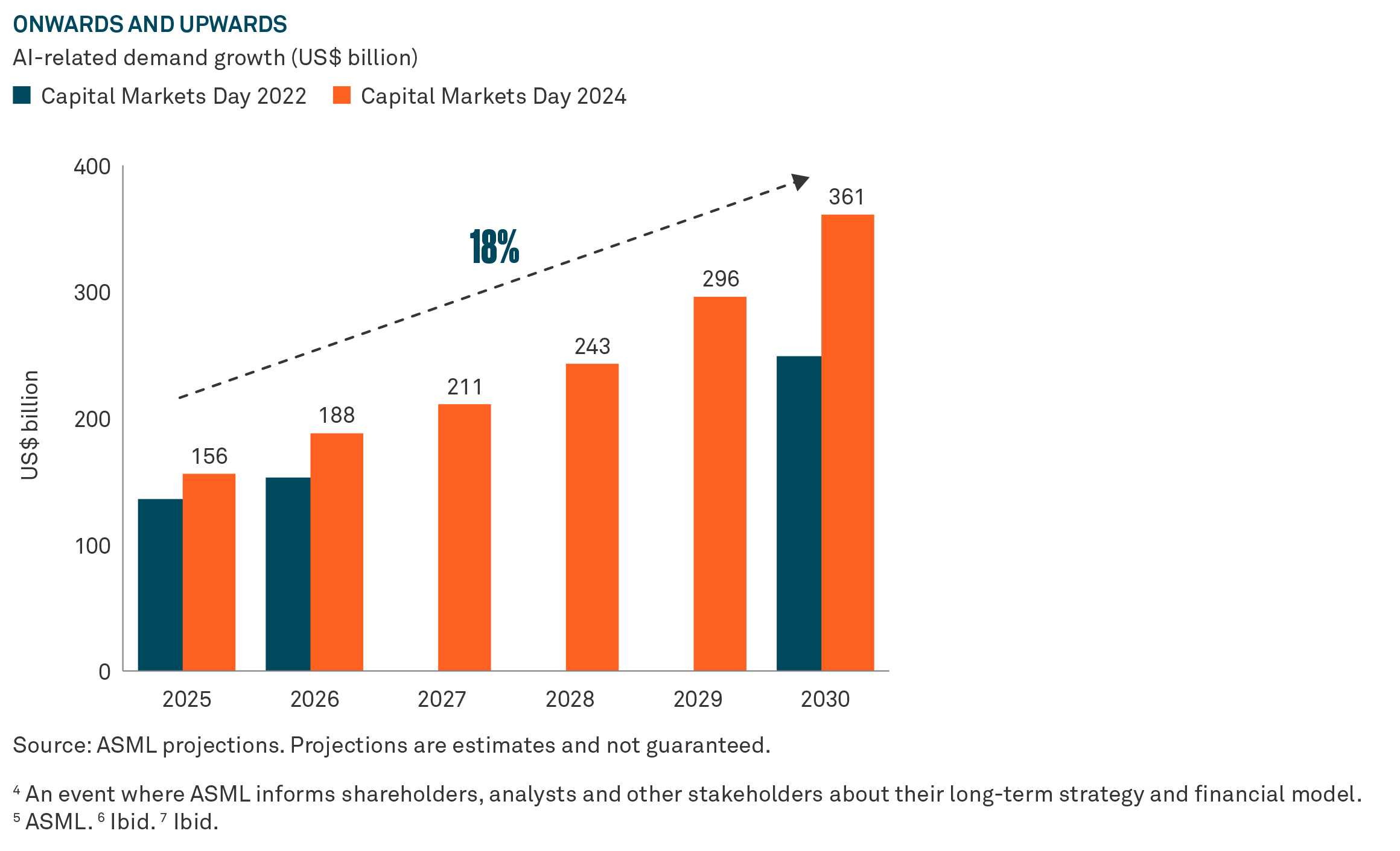March 2025
Author: Tom Miedema, Investment Manager at Walter Scott
Investment views from our
partners at Walter Scott

In November, I was in the Dutch town of Veldhoven to hear the management team at ASML brief investors on the company’s long-term strategy. The update came at an opportune moment. The previous month, ASML’s third-quarter results had triggered volatility across the semiconductor sector, with its own share price falling 16% in the process.1
The catalyst for the sell-off was the announcement of a more moderate growth outlook for 2025 and a decline in quarterly orders for ASML’s lithography machines. Understanding why this news should have sparked such widespread volatility requires some context.
No ASML, No AI?
Spun out of Dutch electronics giant Philips in the 1980s, ASML is the dominant player for advanced microchip lithography,2 the process of transferring patterns onto silicon wafers using light. Importantly, the company holds a monopoly position3 in the most advanced iteration of the technology, extreme ultra-violet (EUV).
Capable of producing incredibly small and complex patterns, EUV allows manufacturers such as Taiwan Semiconductor Manufacturing Company (TSMC) and Intel to compress more transistors on a single semiconductor. Without it, securing the massive computational power demanded by AI chips would be extremely challenging. ASML is one of the few companies that can reasonably claim to be indispensable to the AI revolution.
Reflecting its linchpin status in the global semiconductor supply chain, the company’s fortunes are often viewed as a barometer for the wider industry. They are also increasingly parsed for clues to the health of AI-related demand. October’s news was clearly interpreted by some investors as a worrying indicator for both ASML and for others in the semiconductor ecosystem.
A Question of Time
We took a more sanguine view, seeing little of long-term concern in the results. Quarterly orders, generally lumpy at ASML, are a poor gauge of the company’s progress, in our view. Furthermore, the downward tweak to the 2025 outlook reflected three factors that we believe were more about timing than any structural decline in demand.
First, Samsung and Intel, both major customers of ASML, have been deferring capital expenditure (capex) due to the ongoing struggles of their semiconductor foundry businesses. Both are suffering from low production yields and a lack of customer interest in their efforts.
The result is a deferral of capex and a requirement for less leading-edge lithography equipment over the next few quarters. TSMC, ASML’s largest customer, is the likely beneficiary of this and could ultimately replace demand should Samsung and Intel fail to sort out their challenges.
Second, demand for dynamic random access memory (DRAM) and NAND memory has been more sluggish than expected. Reflecting this, some of the main industry players such as Micron, Samsung, and Hynix have deferred spending by a few quarters to manage the slower than expected upturn in demand. All have new fabrication plants under construction, which will require ASML’s technology, so we are confident that this investment will happen. The only question concerns timing.
Finally, demand from China is normalizing. Having made an outsized contribution this year, the country’s share of overall sales should fall back to a more normal 20% next year. This reversion is simply happening a little earlier than expected.

To 2030 And Beyond
If some investors did have questions about ASML’s long-term growth trajectory, November’s investor day4 should have gone a long way to answering them. Led by new CEO Christophe Fouquet, management outlined a convincing roadmap for growth for the next five years and beyond.
The Big Picture
In 2022, ASML set out expectations for the semiconductor market to be worth over US$1 trillion by 2030, a compound annual growth rate of 9%. Two years later, this is still the company’s base case. Growth expectations remain on track. What has changed, however, are the drivers of that growth.
AI to the Fore
The big change to ASML’s growth projections is the contribution from AI-related demand. The servers, storage and datacenters segment, which is the main beneficiary of the growth in AI, is now expected to account for ~40% of total 2030 demand, a significant increase from 2022 estimates. Summing up this step-change, Mr. Fouquet quipped, “We see our society going from chips everywhere to AI chips everywhere.”
Interestingly, these estimates appear conservative when compared to those recently issued by other industry players AMD and Nvidia. Should their more ambitious forecasts prove correct, that would constitute considerable upside for ASML’s 2030 guidance.
Mainstream Markets Slowing But Still Growing
Alongside this AI-driven growth, ASML revised down the 2030 growth forecasts for what it calls its "mainstream markets." To a degree this was expected. With the semiconductor industry only just starting to emerge from its worst cyclical downturn since the global financial crisis, demand from end markets such as PCs, smartphones and automotives has been sluggish. These markets will likely still grow, many at a healthy pace, but their overall contribution could be lower going forward.
Challenges Bring Opportunities
The transformative potential of AI hardly needs reiterating. By some estimates, it will add between $6 and $13 trillion dollars to global GDP by 2030.5 If AI is to deliver on this promise, however, Mr. Fouquet stressed that “major, major innovation” is required.
The challenge for the semiconductor industry is how to deliver the highest possible computing power and transistor density at the lowest possible cost and with the lowest possible CO2 emissions. If this is going to happen, we expect semi manufacturers to step up investment in ASML’s EUV technology. As a consequence, demand for EUV should comfortably outstrip the 9% growth rate of the wider chip market.
Perpetual Innovation
From its earliest days in a “leaky shed” next to a Philips’ office in Eindhoven, ASML has been a relentless innovator. Since the commercial release of the first EUV machine in 2018, the company has overseen a quarter-on-quarter improvement in the technology’s productivity and availability (the length of time the machine is in operation). From producing less than 140 wafers per hour in 2018, these workhorses of the semiconductor manufacturing process now churn out more than 220.6 That figure is expected to increase again to 250 with the release of the NXD:4000F machine in 2027.7

Conviction Remains High
ASML’s roadmap for growth validated our long-term investment case for the company. With its mission-critical technology and deep competitive moat, we believe the company should remain both an enabler and a beneficiary of one of the most exciting structural trends in the global economy.
As a vital but niche role in the semiconductor ecosystem, ASML styles itself “the most important tech company you’ve never heard of.” As the business builds on its unique position and as AI launches the next chapter in the industry’s remarkable growth story, there appears, in our view, little chance of that importance diminishing soon.
1 Yahoo! Finance UK, October 2024.
2 Morningstar, “ASML is the Leader in EUR Lithography and has Rosy Growth Prospects in our View.”
3 CNBC, “ASML is the only company making $200 million machines needed to print every advanced microchip. Here’s an inside look.”
4 An event where ASML informs shareholders, analysts and other stakeholders about their long-term strategy and financial model.
5 ASML.
6 Ibid.
7 Ibid.
Artificial intelligence (AI) refers to computer systems that can perform tasks typically requiring human intelligence, such as visual perception, speech recognition, decision-making, and language translation.
Capital expenditure (capex) are investments made by a company to acquire, maintain, or upgrade tangible assets like property, plant, or equipment that are expected to provide benefits over an extended period.
Compound annual growth rate (CAGR) is the mean annual growth rate of an investment over a period longer than one year.
Dynamic random access memory (DRAM) is a common type of random access memory (RAM) that is used in PCs, workstations, and servers.
Gross domestic product (GDP) is the total market value of the goods and services produced by a country’s economy during a specified period of time.
NAND is a type of flash memory that stores data in arrays of memory cells using floating gate transistors.
All investments involve risk, including the possible loss of principal. Certain investments involve greater or unique risks that should be considered along with the objectives, fees, and expenses before investing.
Company information is mentioned only for informational purposes and should not be construed as investment or any other advice. The holdings listed should not be considered recommendations to buy or sell a security.
BNY Investments is one of the world’s leading investment management organizations, encompassing BNY’s affiliated investment management firms and global distribution companies. BNY is the corporate brand of The Bank of New York Mellon Corporation and may be used to reference the corporation as a whole and/or its various subsidiaries generally.
This material has been provided for informational purposes only and should not be construed as investment advice or a recommendation of any particular investment product, strategy, investment manager or account arrangement, and should not serve as a primary basis for investment decisions.
Prospective investors should consult a legal, tax or financial professional in order to determine whether any investment product, strategy or service is appropriate for their particular circumstances. Views expressed are those of the author stated and do not reflect views of other managers or the firm overall. Views are current as of the date of this publication and subject to change. This information may contain projections or other forward-looking statements regarding future events, targets or expectations, and is only current as of the date indicated. There is no assurance that such events or expectations will be achieved, and actual results may be significantly different from that shown here.
The information is based on current market conditions, which will fluctuate and may be superseded by subsequent market events or for other reasons. References to specific securities, asset classes and financial markets are for illustrative purposes only and are not intended to be and should not be interpreted as recommendations. Information contained herein has been obtained from sources believed to be reliable, but not guaranteed. No part of this material may be reproduced in any form, or referred to in any other publication, without express written permission.
Walter Scott & Partners Limited (“Walter Scott”) is an investment management firm authorized and regulated in the United Kingdom by the Financial Conduct Authority in the conduct of investment business. Walter Scott is a subsidiary of The Bank of New York Mellon Corporation.
© 2025 BNY Mellon Securities Corporation, distributor, 240 Greenwich Street, 9th Floor, New York, NY 10286.
MARK-662456-2025-01-06